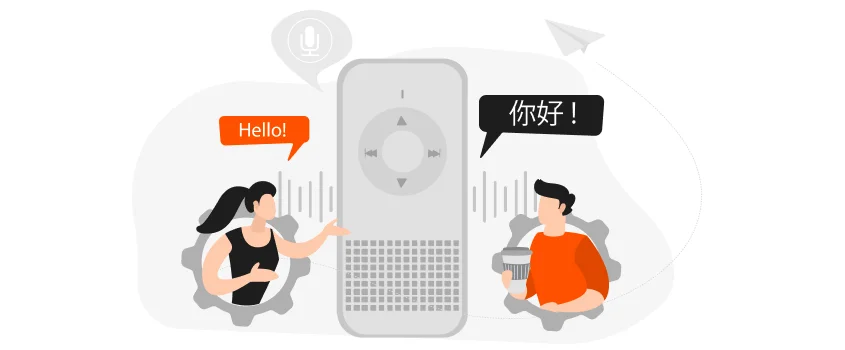2025 Offer Request a Quote Today and Grab a $50 Coupon for Free!
Medical translation is one of the most complex and technical areas of translation. It includes rendering all elements related to the healthcare and pharmaceutical industry into other languages. For instance, a medical office may need to translate a pamphlet for its patients. Similarly, a hospital may need to adapt its clinical research documents and regulatory data for a different target audience. Hence, the translation needs in the healthcare sector could be many.
Medical translation is different from any other general translation. Here are the two most important aspects of it.
If we just look at the importance of medical content or the complexity it involves, we can understand how essential quality and accuracy are in medical translations. If a translation isn’t up to professional standards, it can prove fatal and put human lives at risk. Probably this is the main reason why the medical industry around the world is highly regulated, compared to other industries. Any medical office or healthcare setting will have to work with professional translation agencies instead of opting for freelancer medical translators. The benefit of working with such agencies is that they can demonstrate compliance and accreditation with international quality standards.
The medical field uses specialized vocabulary. Professionals working in this sector should have a strong understanding of all the healthcare terminology. Otherwise, they won’t be able to deliver their job successfully. It’s imperative for medical translators to not just have a mastery of medical terminology but also excellent language skills they are translating into. Another must-have for a linguist in the medical industry is to have relevant cultural awareness. A translator who knows the differences between different cultures can effectively bridge the communication barriers between patients and medical offices.

The medical industry is global. It serves numerous markets and audiences around the world who speak other languages. This pretty much explains why there is high demand for medical translations. To meet these high demands, translators must be linguistically fluent and aware of specific terminology to produce translations for various types of medical translation.
When collecting patient information, it’s crucial to handle everything clearly and correctly. And translation is also one part of the process. Medical offices need to translate patient information forms into their native languages. But this does not end here. There is also the need to translate those forms back into the language of doctors and physicians.
Translating consent forms is one thing and maintaining accuracy is another. Patients and families have the right to be fully aware of what procedures and medications will come into practice. Once they understand what treatment they will receive, they can offer their well-informed consent. Now if patients or their families receive a form with an inaccurate translation, they might end up giving their consent while being unaware of the whole treatment. And not only this can result in medical implications but legal implications as well.
Suppose you’ve offered the treatment and everything has been fine. But does the process end here? No. Still, you will have to communicate with patients about how they should use the prescribed medication for their condition. After all, we all get such medical guidelines which read: “2 or 3 times a day with milk, food or water, etc. for x amount of time”. This is just to give you a simple idea of what healthcare guidelines could be.
However, in some cases, the prescription details are very complex. Consider a case when a medication can counteract other treatments or pills a patient might be on. Similarly, there could be instances where a certain type of food isn’t permissible with the medicine. All this requires full accuracy of medical translations so that there are no critical errors down the road. If there are any, they could prove detrimental to both patients and medical facilities.
In medical offices and healthcare facilities, the use of signs is commonplace. They help the patients along with other visitors to comfortably navigate the place. In order to ensure there is no confusion and your patients feel comfortable, the signs should have different versions of them in other languages. These languages could be the most popular languages that people in your area generally speak.
This will also require you to conduct proper research about what languages people in your community generally use. For instance, in the melting pot, the U.S., there exists a huge variety of languages. Some of the most common languages other than English include Spanish, Chinese, Filipino (Tagalog), Vietnamese, and French. So, decide carefully which languages people mostly speak in your region.
No medical office or facility can be operationally efficient without providing effective medication support to patients of diverse backgrounds. If there are circumstances like a pandemic, then an extra layer of urgency is added to this. Such as when Covid hit, it forced people to stay away from each other in most ways. However, there emerged an ever-great need to connect with one another through the use of language and culture. This is why it’s vital to integrate medical interpretation services into any healthcare office or institution. This guarantees patients’ comfort and helps ensure compliance with legal obligations. However, interpretation services are not always on-premise. In fact, over-the-phone interpreting is possible. After the pandemic, these over-the-phone or video remote interpreting services are, in fact, more in demand.

Medication translations are not just confined to medical offices and healthcare settings. Rather, these translations are carried out in various other areas of the medical industry as well. This includes but is not limited to, clinical trials, medical research, patents, drug development, patents, market research, and more. Let’s look at some top medical translation types outside of medical offices and healthcare facilities.
One of the effective ways the medical field can grow is through research work and studies. Researchers publish so many articles in various journals across the world. All stakeholders should encourage the spread of these vital findings and critical data throughout the global community of healthcare experts. However, not all scientific article authors are fluent in English which is a common language for international medical journals. For this reason, they need to translate their medical research documents into English. But, accurate translations are only possible when you work with a professional translation agency. Otherwise, you run the risk of poorly translated medical text.
The pharmaceutical and medical industries are a very demanding and competitive type of industries. In their efforts to sell their cutting-edge products around the globe, they have to enter new markets and new geographies. However, before launching their business in a foreign land, they conduct market research.
This research tries to find whether the target country will be a good option for their product acceptance as well as to figure out pricing and the right brand messaging, etc. All this depends on the specific demographics that live in the target country, as well as the activities competitors are doing. So, all the market research documents must go through a translation process so that everyone who needs this exclusive market research data can have easy access to it, and that too in their native language.
Medical devices could be any equipment or tool for rendering medical care. Ranging from thermometers to infant incubators, these devices are important in saving patient lives. Therefore, it becomes crucial to use them in a proper manner. But for their proper use, these devices must have all their related information in the native language of the country. This goes from packaging to marketing materials, user manuals, and anything in between.
Once all the content is available in local languages, the doctors and patients will be able to understand the instructions to assemble and operate it, etc. Plus, the medical devices should meet the local regulatory requirements as well. For these reasons, companies work with subject matter experts to translate their medical devices. These subject matter specialists don’t just have the medical knowledge but draw on their engineering and physics background to accurately translate different parts of medical devices and their operation.
There is no way to secure a new product without guaranteeing that the idea will remain yours in other countries as well. This is why it’s important to consider patent translation services for your products and services. Accuracy plays a critical role in this type of translation. Because you can apply for patent rights in multiple countries around the world, therefore the need for appropriate translations is essential.
On a broad level, there are two types of patent translations. One type of patent translation is for information and the other is for filing. You need to understand the difference between the two types, only then you can make the best decision. Both differ based on their purpose and target audience.
For instance, if you need to translate your patent for filing, then you must know that such patents are used in the application process. The target audience in this case will be the legal professionals and patent officials who will have to review your application.
On the other hand, patent translation for information is only required once the application process is finished. Here the focus is to learn and provide informational context for the contents of the already filed patents. Whatever the patent translation you might need, quality is of utmost significance. Otherwise, your whole patent application process can slow down.
A clinical trial is a special type of research study that aims to evaluate the effects of different tests and treatments on human health. In order to launch and conduct a clinical trial, translations have a great role to play. Because participants need to be aware of trials and possible health risks before going into the trial. Therefore, accurate translations for clinical trials are needed.
In today’s day and age, the majority of clinical trials happen in foreign countries. According to statistics, the top 20 American pharmaceutical companies are also carrying out 33% of their clinical trials in other parts of the world. The rules and regulations vary from country to country, and region to region. For example, the laws in the United States dictate that all documents directed at patients and investigators must be available in relevant local languages. When American research companies conduct their trials in other foreign countries, the Food and Drug Administration (FDA) insists that they should maintain all ethical standards. This explains why expert clinical trial translations are in high demand. The popular types of clinical research documents that require these high-quality translations include:
Since the medical field is very diverse and has a vast amount of procedures and documents, chances are we might have missed something. However, our focus was to highlight some of the most common areas and medical documents that need translations. These document types either affect doctor-patient interactions or are related to international reputation. Following are some more content types in the medical field that also require multilingual translations:

When medical offices and healthcare facilities implement medical translation services, it’s a win-win situation for everyone: from clinics and doctors to patients.
In order to produce medical translations, the translators must have an in-depth and vast knowledge of the medical field. That’s why most translation companies employ linguists who have expertise in one or more medical branches and have mastered the specific terminology. But each branch of the medical field also has various nuances to it and requires advanced skills on the part of the translators. Even after attaining this level of knowledge and expertise, medical linguists are still prone to make risky errors in translations.
With that said many companies around the world claim to provide the most reliable and accurate translations for medical offices and the healthcare industry in general. These translations are commonly available for all document types mentioned above and more, such as patient information forms clinical trial documents, etc.
That’s why it’s critical to select the right provider that can meet your specific needs. The best way forward is to work with a company that has expertise in the life sciences. Apart from industry specialization, look at the number of languages they understand and can provide support for. The best medication translation services will be the one that has a native team of professional translators spread around the world. Plus, they shall give you the option to choose between any language pair in the world, that too at competitive prices.

In this blog, we will discuss 12 different types of translation. Types of translation help us to understand the diversity in
Read more
Mars Translation has a huge team of professional and experienced translators who understand their target language and can deliver the
Read more
San Francisco is a city in Western California. It is famous for its beautiful settings and it is built on
Read more
San Diego is California's second-largest city, and it has a population of 1.3 million from which three million residents are
Read more
Los Angeles is the largest city in California. It is also known by its initials L.A. This city is renowned
Read more
Dallas is the largest state in Texas after Houston and San Antonio. It is the ninth most populous city in
Read more
Austin is the capital city of the US state of Texas. It is the 11th most populous city in the
Read more
Mars Translation provides Thai legal translation services for almost all kinds of legal needs. We have a huge team of
Read more
MarsTranslation provides professional Spanish Website Translation services all over the world. We have hired only the best of the best
Read more

